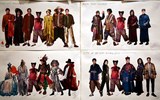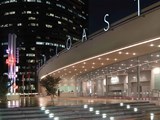by Tania Thompson
Designing Costumes for "Where the Mountain Meets the Moon"
Costume designer Anthony Tran is breathing life into some 30 costumes that the seven actors in Where the Mountain Meets the Moon (Feb. 7-23, 2020) will wear to help tell the story. The musical, adapted from Grace Lin’s award-winning 2009 book by the same name, follows young Minli, who sets out on a big and magical adventure to help her village find prosperity and health again. During her journey, she draws strength from the folktales that her father (Ba) told her, as she encounters many strange and wonderful creatures along the way—including a dragon and a green tiger.
Tran is a Los Angeles-based designer for stage, film and television. His recent credits include “Teen Beach 2” (Disney) and “Star Trek: Picard” (CBS All Access). We caught up with him during rehearsals for Where the Mountain Meets the Moon.
What inspired you to get into costume designing?
As a kid, I drew all the time. I would watch movies and draw my own versions of the characters. When I discovered that costume design could be a profession, it clicked that I had unintentionally been preparing to be a costume designer since I was a little kid!
What’s your favorite part of the job?
My favorite thing about being a costume designer is that it is a combination of many things I enjoy—art, design, history, research and storytelling. I am always learning something new and enjoy collaborating with other artists. There's never a dull moment.
What interested you most about Where the Mountain Meets the Moon?
What intrigued me about the show is that it's the quintessential hero's journey, only our protagonist (Minli) isn't the traditional trope. The scope of the story is epic and I was excited to take on the challenge of designing the costumes for the various creatures Minli encounters.
How do you develop both the designs and color palettes for the costumes?
Our director Jennifer [Chang] and I both agreed that we didn't want the look of the costumes to feel too traditional. Rather, we wanted to blend different aesthetics to create an east meets west feel. For example, Minli wears her traditional qipao top with contemporary graphic overalls. Because Minli travels to many different places, I wanted to create distinct cultures for each location that are reflected in what the characters wear.
We start in Fruitless Mountain, where the villagers toil away, so I kept the color palette in sunset tones a la an arid desert. When Minli arrives in the City of Bright Moonlight, there is a metropolitan feeling and all the fabrics are rich brocades (pseudo-inspired by The Wizard of Oz). For Moon Rain Village, all of their clothes are patchwork to reflect the tight, small-town nature of the community.
Tell me about designing costumes for the creatures that Minli meets along her journey.
The fantastical creatures Minli encounters also follow that same mixing of references and aesthetics. Dragon's look was inspired by costumes worn in Beijing Opera, mixed in with a 2016 Dsquared² runway collection that was filled with these interesting tattoo shirts. Goldfish's dress is traditional Chinese Hanfu, but we added clear plastic bubbles (a la Lady Gaga's bubble dress!) to simulate sea foam. Tiger wears traditional Chinese set and Tang dynasty-era head and also wears his Liberace-meets-stuffed-animal fur coat. The idea was to mix traditional garb with modern taste, keeping things elegant and playful at the same time.
What type of fabrics and textures do you favor for this show?
I keep a pretty open mind when it comes to materials. Fruitless Mountain is full of solid colors of cottons and linens. The City of Bright Moonlight is mostly brocades. Moon River Village is mostly cotton prints. We're getting really crafty with all the creatures’ costumes and using everything from foam to newspaper to old Christmas ornaments.
What is the life journey of a costume—from design, to build to performance—how does it come together?
The journey from design to finished product involves the work of so many skilled people. I start by making renderings of my designs. Then, it takes a village to turn that into reality. We source clothing, fabrics and supplies from all over the world (thanks to the magic of the internet). And SCR has so many skilled artisans in the Costume Shop who help realize everything. We hone things in during fittings with the actors and they breathe new life into it over the course of technical and dress rehearsals. Sometimes things work exactly as envisioned and sometimes we adjust. It's a very collaborative process that's ever evolving.
Do you have a favorite folktale or fairy tale from childhood—and why do you think it appealed to you?
I have so many, but Cinderella stands out. I'd seen the classic Disney version and then my parents showed me a video of a Vietnamese version. The fantasy and drama are fun and exciting for a kid, but they also exposed me to the universality of storytelling. There's a version of the Cinderella tale in so many different cultures. That really is the beautiful thing about stories: they tie us all together.


